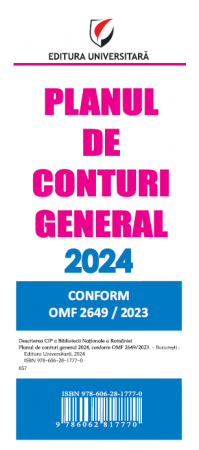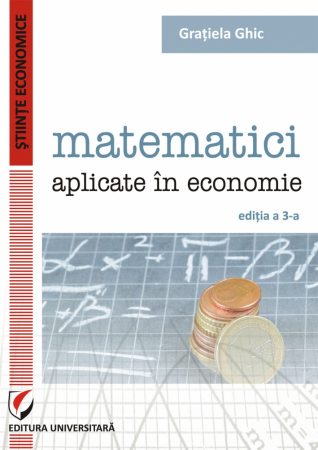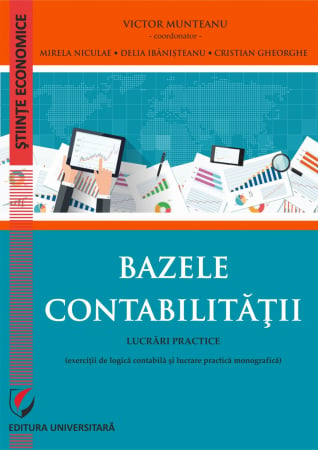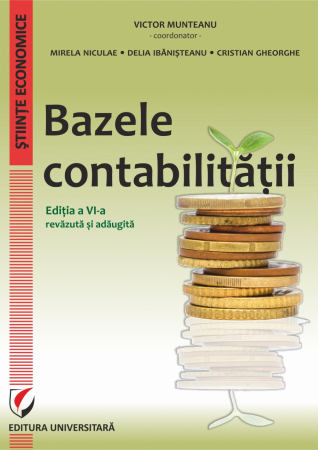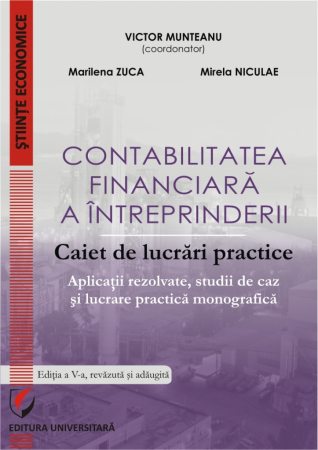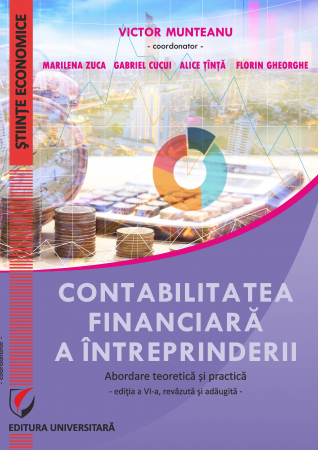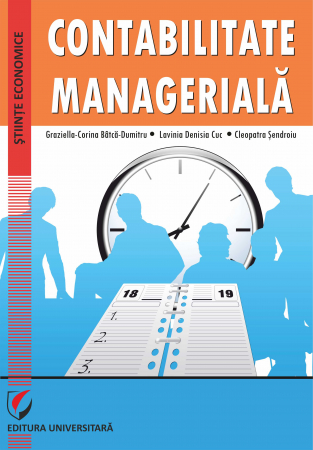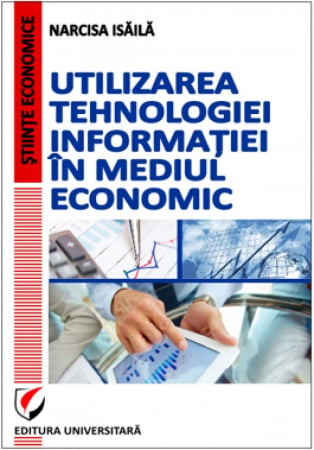Publisher: Editura Universitară
Author: Isa Tak
ISBN: 978-606-28-0171-7
DOI: 10.5682/9786062801717
Publisher year: 2015
Edition: I
Pages: 192
- Description
- Download (1)
- Authors
- Content
- More details
- Reviews (0)
The financial information prepared through the accounting department is presented to the decision makers following some relevant control stages.
In the light of this information, the decision makers will be able to make a decision. However, the accuracy of financial information will positively or negatively influence the decision-making process.
In many parts of the world it is in the interest of companies to play with the figures in financial information. Small companies are looking for ways to show as low an income as possible in order to pay a lower income tax, while large companies (corporations) are trying to attract large-scale investors by showing high profits.
In both cases, the intentional mistake and the tricks used affect the future of the company, and can become a disaster for the future of the company, as it negatively affects society and the state given that we actually live in a global world.
Since its inception, mankind has demonstrated in various ways, the sense of ambition and thus damaged our only world in which we live.
The desire to gain as much as possible, to have prestige, the desire to occupy the highest positions, and the like, are material aspirations and only by suppressing these negative feelings, it can be a mechanism of spiritual functioning of man who will be able to channel these feelings into positive activities. Otherwise, it will be increasingly difficult for limited resources to be distributed equitably among the world's populations.
The book consists of four chapters. These were ordered as follows; the first chapter Financial Information and its Importance at National and International Level, the second chapter the International Financial Reporting Standards (IFRS), the International Accounting Standards Committee (IASB) and the International Accounting Standards (IAS), the third chapter Case Study „Carrying out the Internal Control in order to Detect and Correct Errors and Frauds at SC ABC SA and the fourth chapter Conclusions, Proposals and Opinions.
The first chapter defines the financial information, presents the importance, objectives, users, types and importance of the demand and supply mechanism, includes financial-accounting information and aspects such as user quality (user quality). This chapter envisages the provision of financial information relevant to the purpose of this section by providing the information necessary for a better understanding of the applicable part of the paper.
In the second part, the standards and norms provided in the international financial reporting system and the international accounting norms are presented to the reader in a detailed way. The applicative part of the study is in line with the international accounting standards that have always been considered.
The third section of the book in which the main emphasis is on the applicative study (case study) of frauds and errors in a company by evaluating them in accordance with international accounting standards. Topics to be considered through applications will present issues that may constitute error and / or fraud that any business organization may face, and to which managers need to be much more careful.
In the fourth chapter, and the last part of the study are presented conclusions, proposals and ideas. As a result of the activity taken as a whole, and in the light of these results the necessary recommendations were formulated. It is presented the table that must be composed of the structure of financial information and how they are processed, corroborated with practical applications thus forming in front of us an image of the results obtained after which are mentioned the precautions to be taken - recommendations.
-
APLICATII PRACTICE PRIVIND IDENTIFICAREA ERORILOR SI FRAUDELOR FINANCIARE INTR-O ÎNTREPRINDERE
Download
FOREWORD / 7
INTRODUCTION / 9
CHAPTER I.
FINANCIAL INFORMATION AND ITS IMPORTANCE AT NATIONAL AND INTERNATIONAL LEVEL / 12
1.1. Financial information - The notion of information / 12
1.2. Informational content of financial statements / 17
1.2.1. Statement of financial position / 18
1.2.2. Situation of the global result / 23
1.2.3. Statement of changes in equity / 26
1.2.4. Cash flow statement / 28
1.2.5. Accounting policies and notes / 29
1.2.6. Information collateral to the financial statements / 32
1.3. Users of financial information and access to information / 33
1.3.1. Creditors / 35
1.3.2. Owners, shareholders and managers / 36
1.3.3. Employees / 37
1.3.4. Suppliers and customers / 38
1.3.5. Government agencies / 38
1.3.6. Potential partners / 39
1.3.7. Fund managers and specialists / 39
1.3.8. The public / 40
1.4. The importance of financial-accounting information in the economy and the demand-supply mechanism / 41
1.5. The quality of financial-accounting information and its users / 52
1.6. Purpose of the financial statements / 65
1.6.1. Purpose of the financial statements in the vision of IAS 1/68
1.6.2. Frequency and reporting period / 69
1.6.3. Comparative information / 69
CHAPTER II.
INTERNATIONAL FINANCIAL REPORTING STANDARDS (IFRS), THE ACCOUNTING STANDARDS OF THE INTERNATIONAL ACCOUNTING STANDARDS (IASB) AND THE INTERNATIONAL ACCOUNTING STANDARDS (IAS) / 73
2.1. International Financial Reporting Standards (IFRS) and International Accounting Standards (IAS) / 73
2.2. International Federation of Accountants (IFAC) / 74
2.3. Administrators of IASBF / 78
2.4. International Accounting Standards Board - IASB / 80
2.5. Standards Advisory Council / 82
CHAPTER III.
CASE STUDY „PERFORMING THE INTERNAL CONTROL IN VIEW OF DETECTING AND CORRECTING ERRORS AND FRAUD AT S.C. ABC S.A. ” / 84
3.1. Permanent information / 84
3.2. Performing internal control at S.C. ABC S.A. / 88
3.2.1. Introduction / 88
3.2.2. Presentation of the patrimonial situation before the exercise of the internal control / 89
3.2.3. Carrying out the internal control on components of the Financial statements / 93
CHAPTER IV
CONCLUSIONS, PROPOSALS AND OPINIONS / 184
In the current context, current and strategic decisions must be based on an in-depth analysis of all the elements that make up the economic universe.
Seen in this context, the book elaborated by the university lecturer. Dr. Isa Tak entitled "Practical applications for identifying financial errors and fraud in a company" is said to be a useful and topical work.
The paper includes, in addition to theoretical and methodological elements and practical applications arranged in an orderly manner on the activities and priority issues that are the basis for making appropriate decisions.
In order to facilitate the use of the applications in this paper as a tool for conducting economic activity, it is presented in a clear and accessible form to practitioners methodological references providing a modern means of evaluation and scientific elaboration of decisions in the complex of phenomena that occur in life. daily life of economic agents, companies and national utilities as well as at the level of public institutions.
The methodology presented by the author, as well as the practical examples give the work a special importance, it being a wide method of applicability in all sectors of activity.
The methodological references presented are based on scientific research and are adapted to current economic conditions and the development of strategies.
University lecturer Dr. ec. Isa Tak from the University of South-Eastern Europe Lumina in Bucharest made an ACT OF CULTURE in this publication.
Economic culture is not a luxury, but a necessity, thus having to understand with deep wisdom the significance of the connection between economic and political, but especially to understand that economic issues are indestructibly linked to the most burning issues of history, and how they are solved depends on social and economic progress.
Based on the above-mentioned paper, managers, directors, heads of departments in charge of the information system offered by this publication can elaborate high-yield decisions regarding the present as well as the future.
Renowned authors have come to the conclusion that between a good and a very good decision there can be differences of millions.
I point out that Mr. University Lecturer. Dr. Isa Tak appealed in the elaboration of his work to a select and very current bibliography, both indigenous and universal.
The paper is addressed to economics students, teachers, entrepreneurs, managers, researchers, providing rich information systematically organized.
Prof.univ.dr.ec. Gheorghe Blidaru
University of Southeastern Europe Light

6359.png)
![Practical applications for identifying financial errors and fraud in an enterprise [1] Practical applications for identifying financial errors and fraud in an enterprise [1]](https://gomagcdn.ro/domains/editurauniversitara.ro/files/product/large/aplicatii-practice-privind-identificarea-erorilor-si-fraudelor-financiare-intr-o-ntreprindere-844-84718.jpg)
